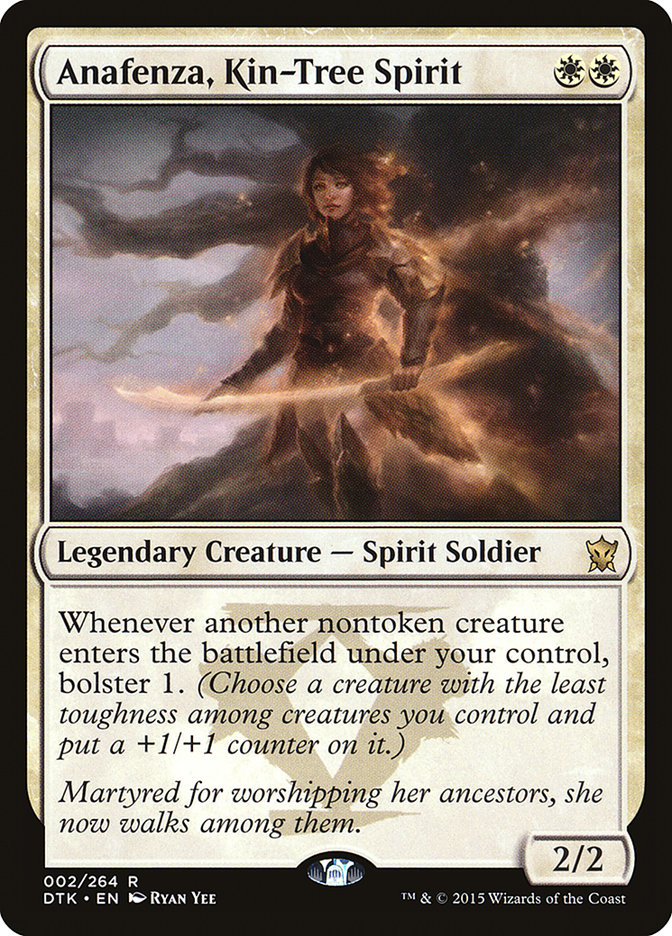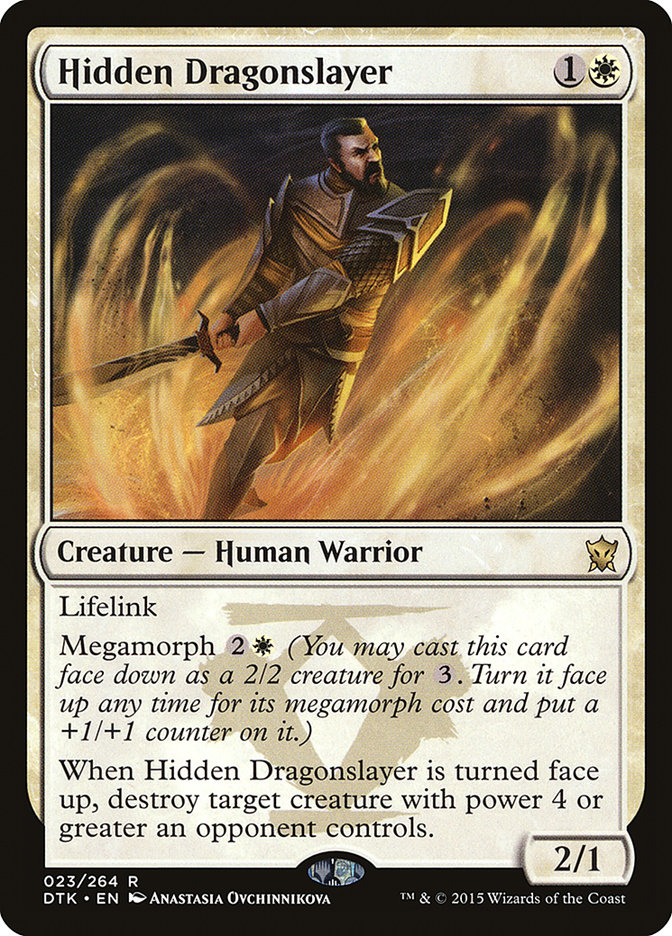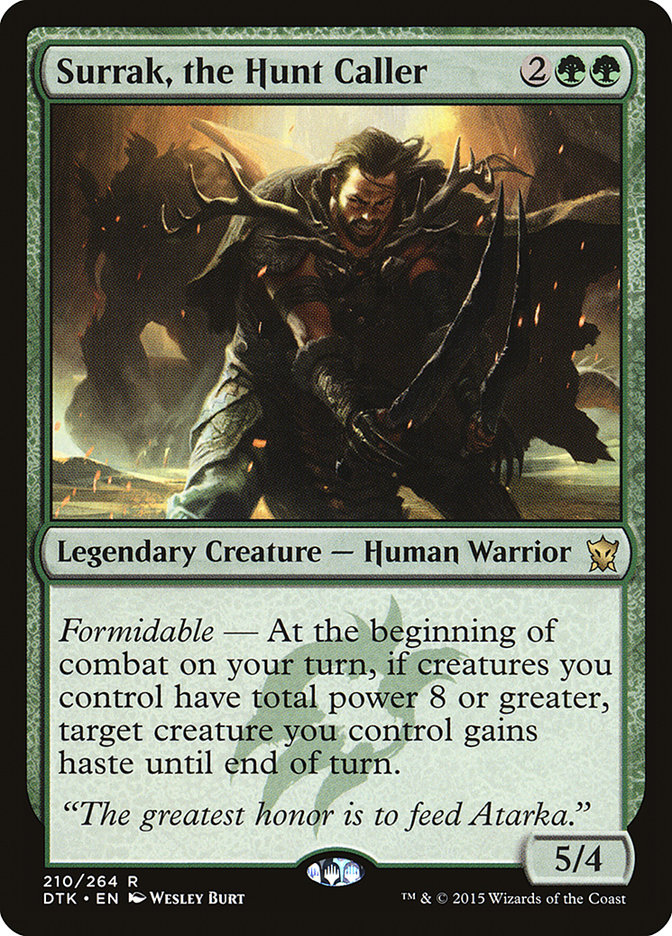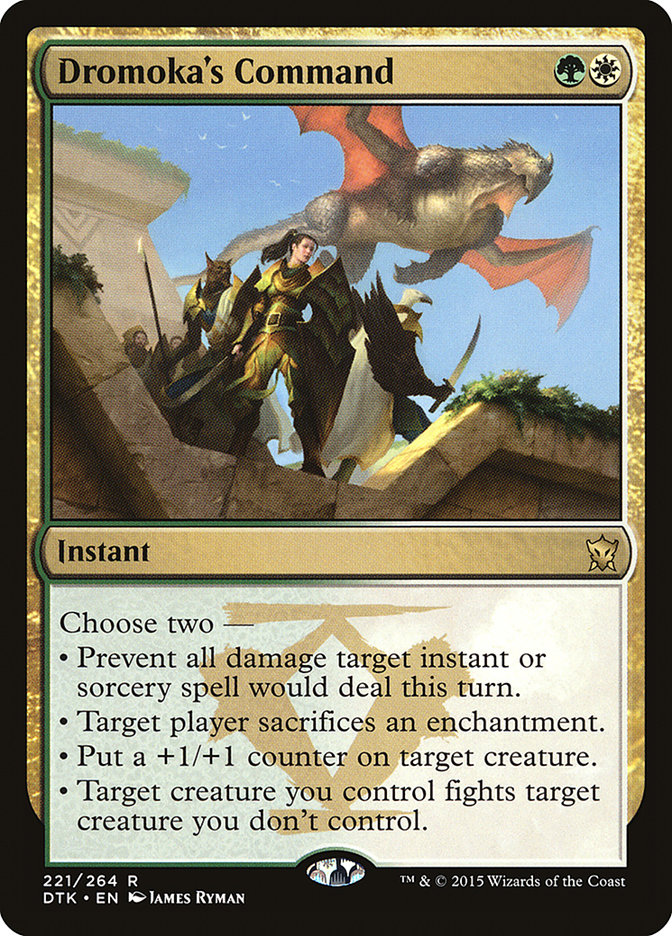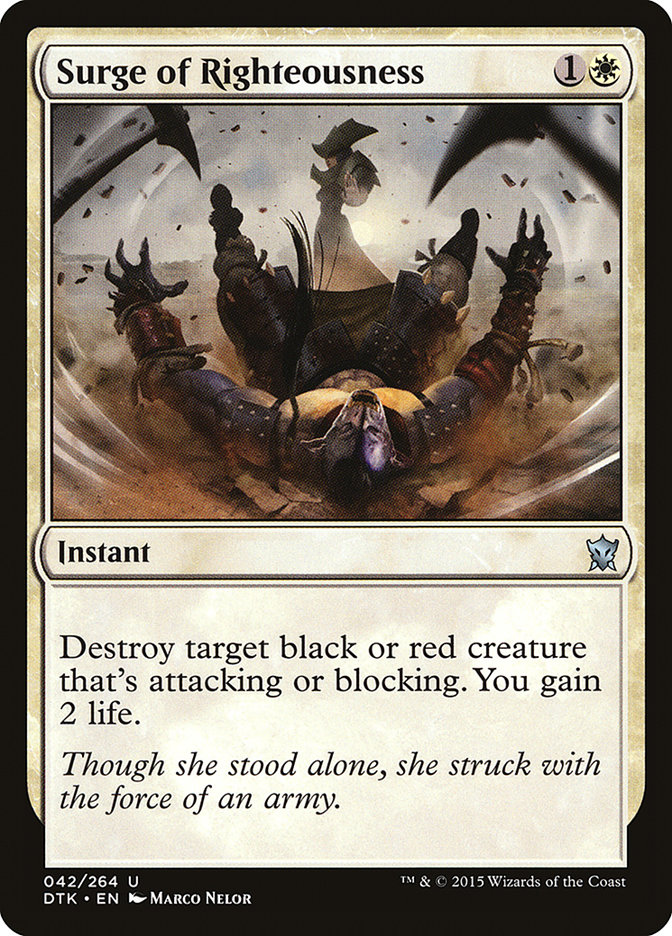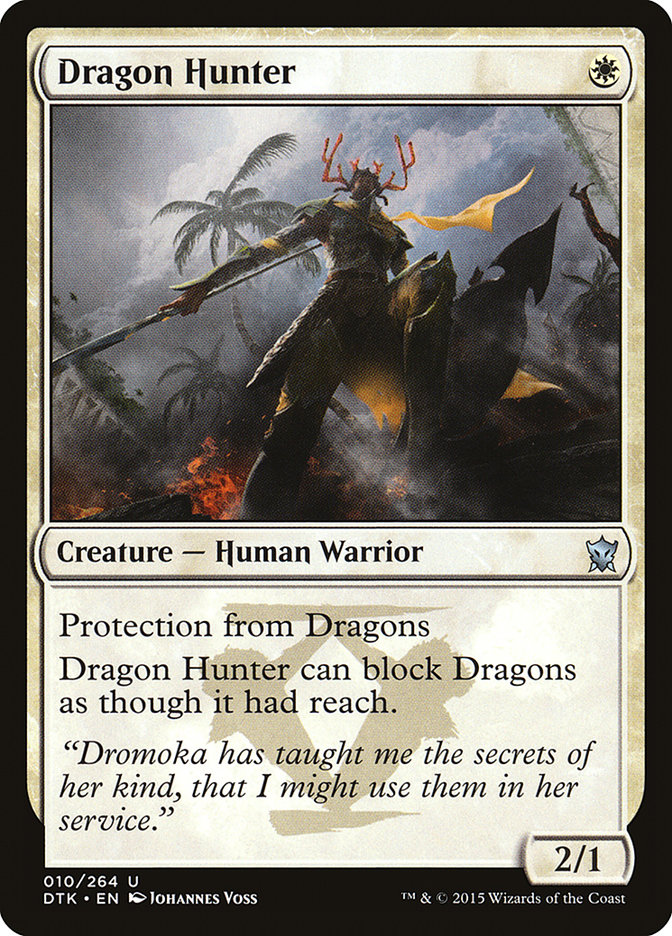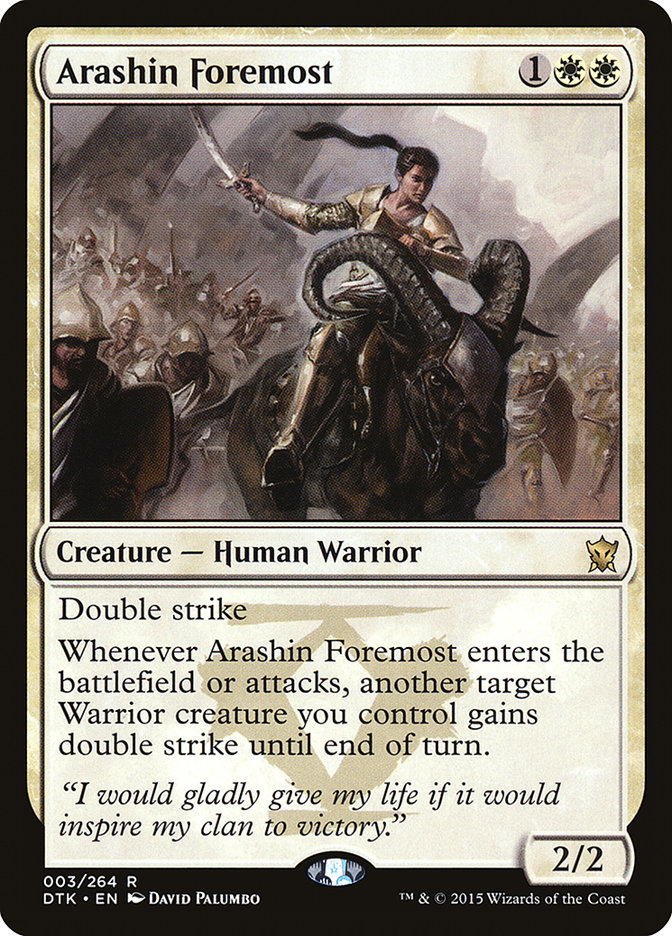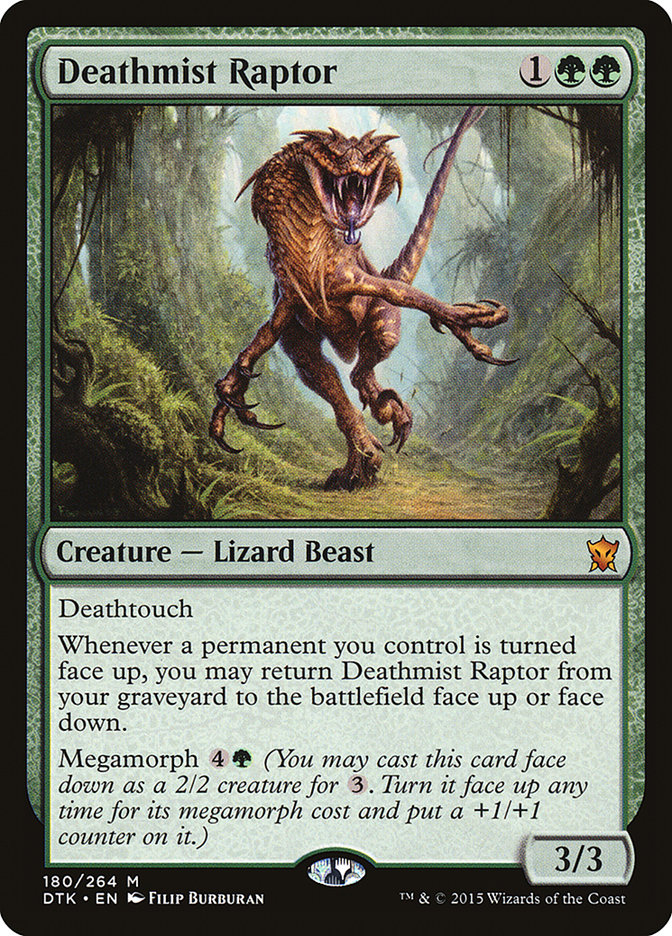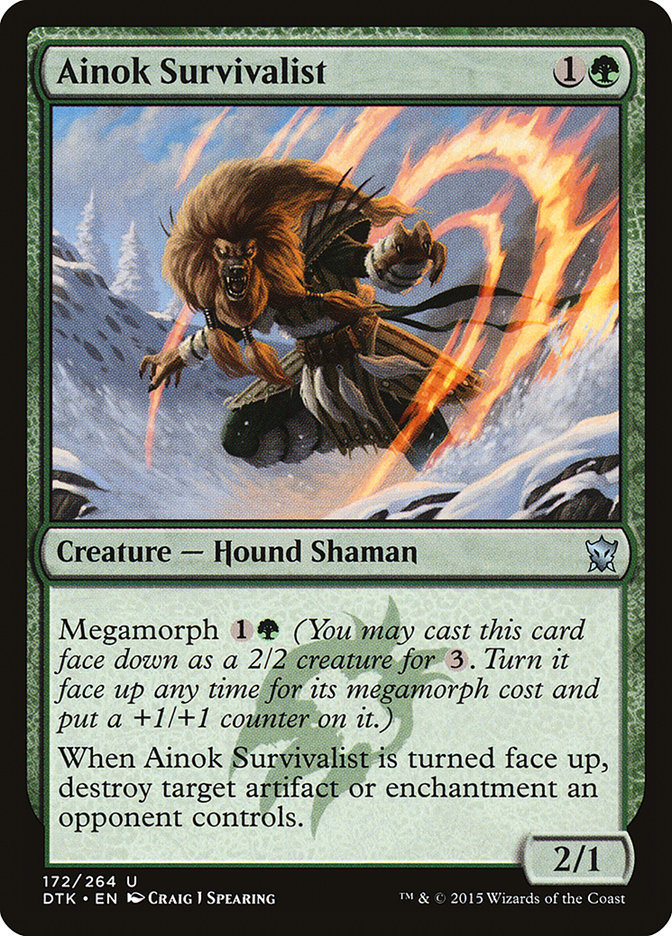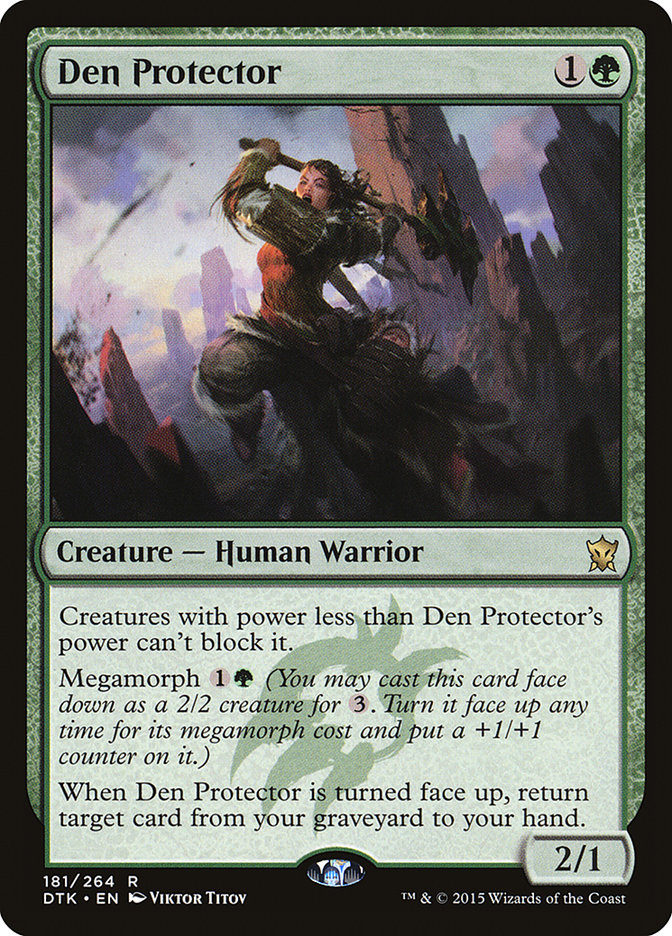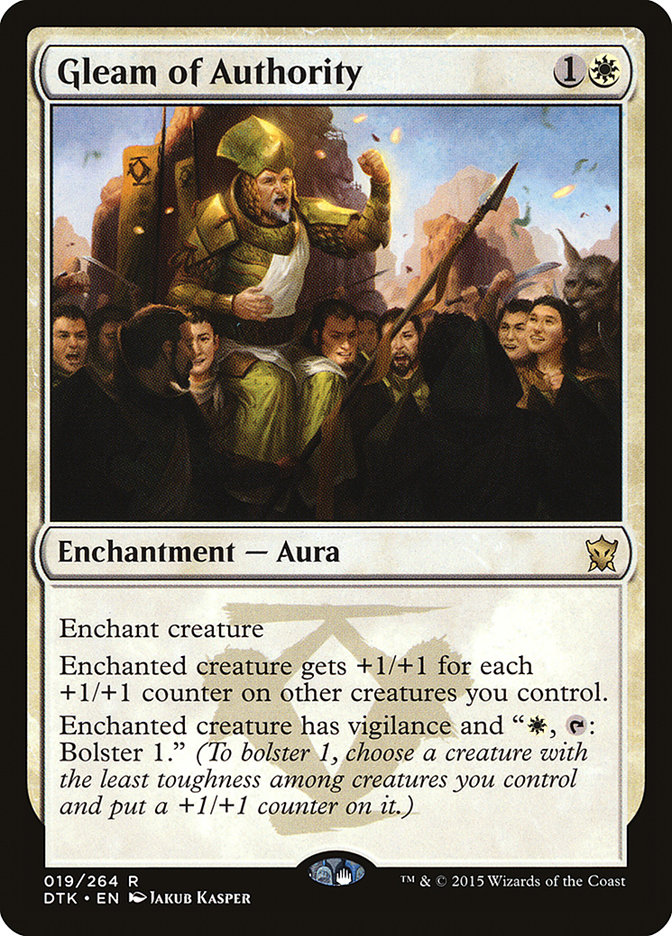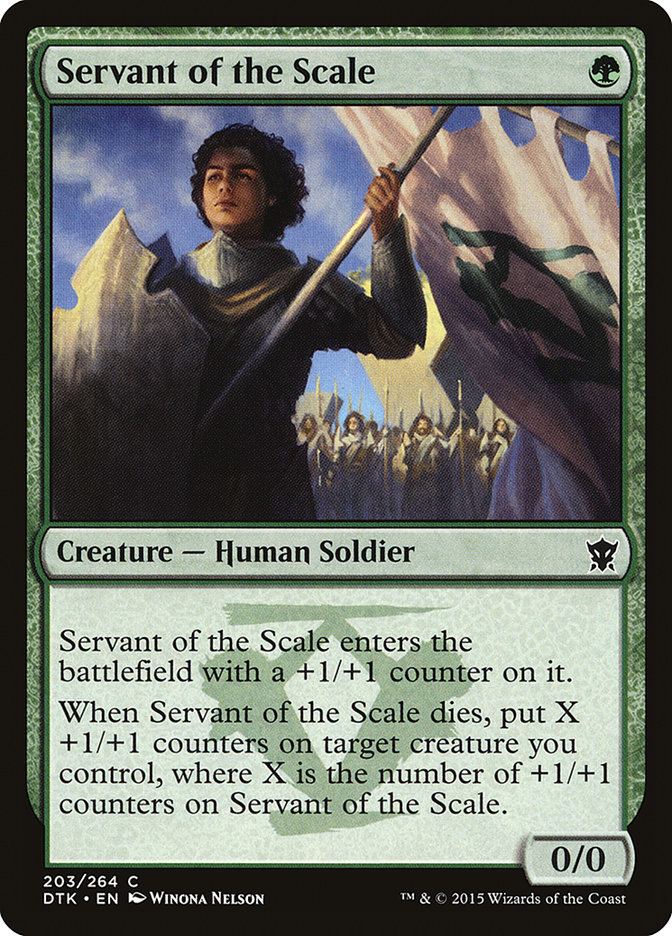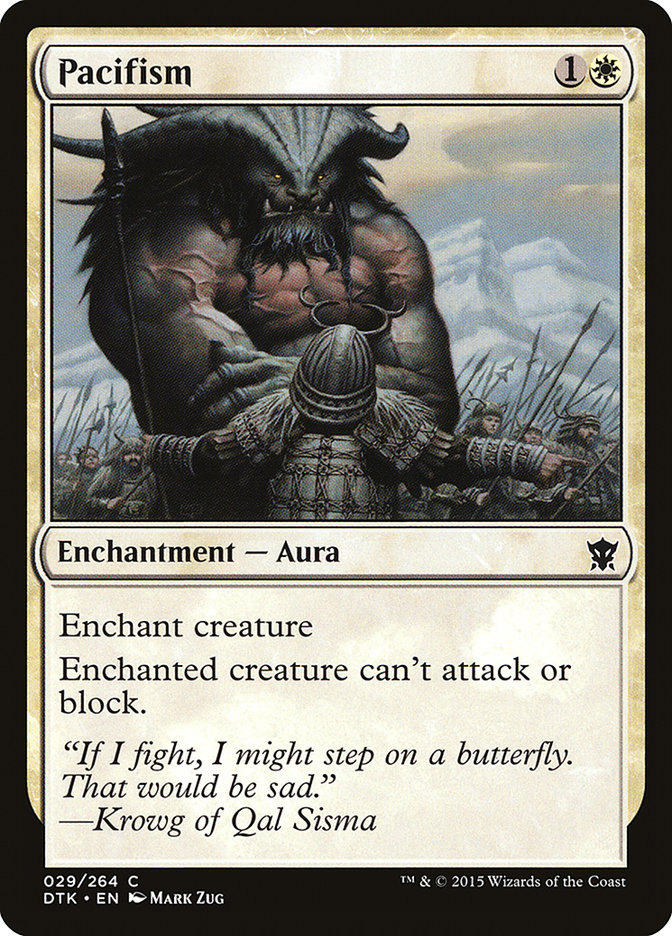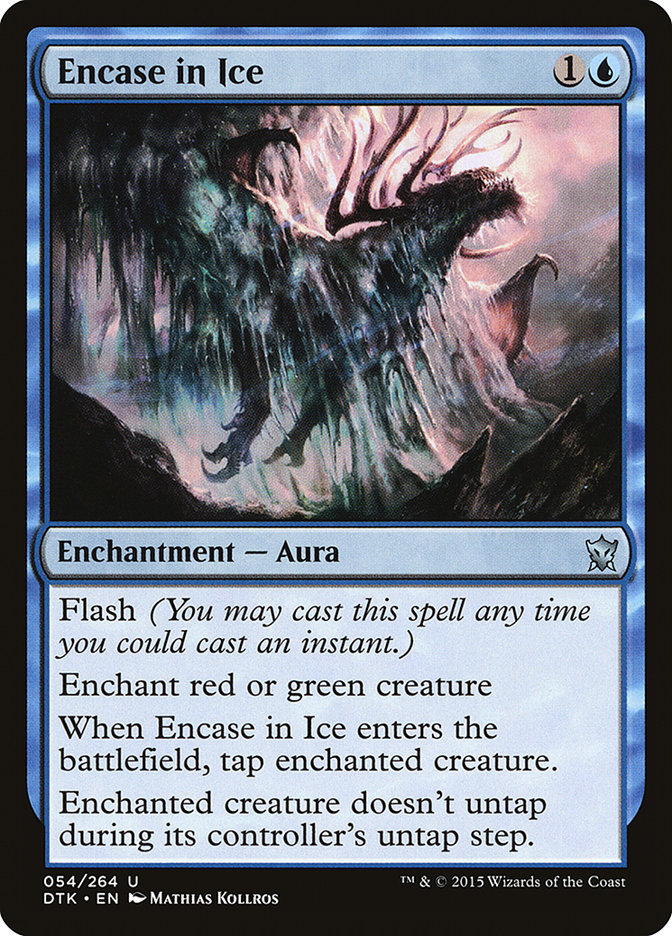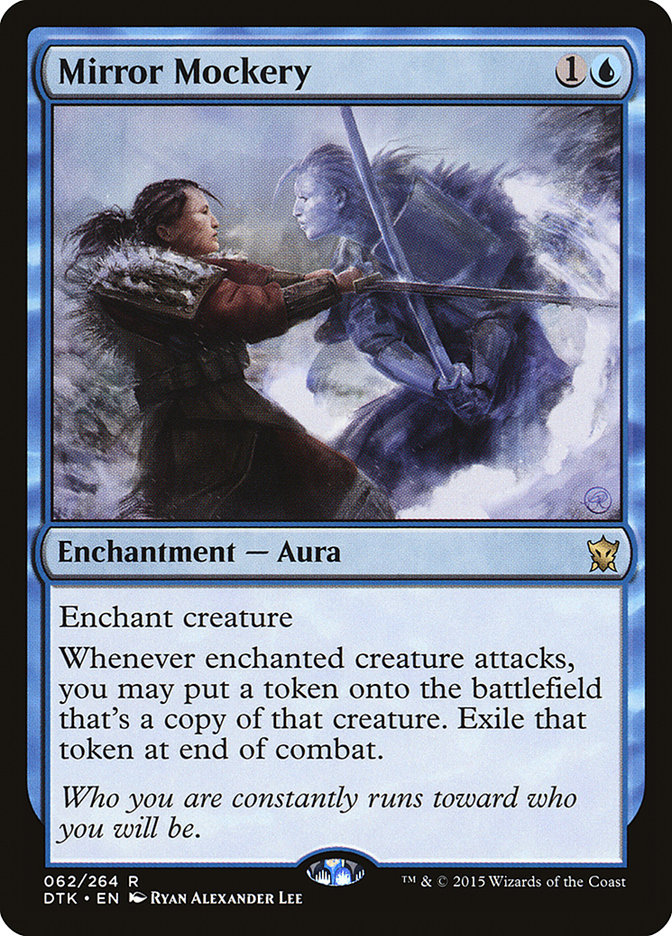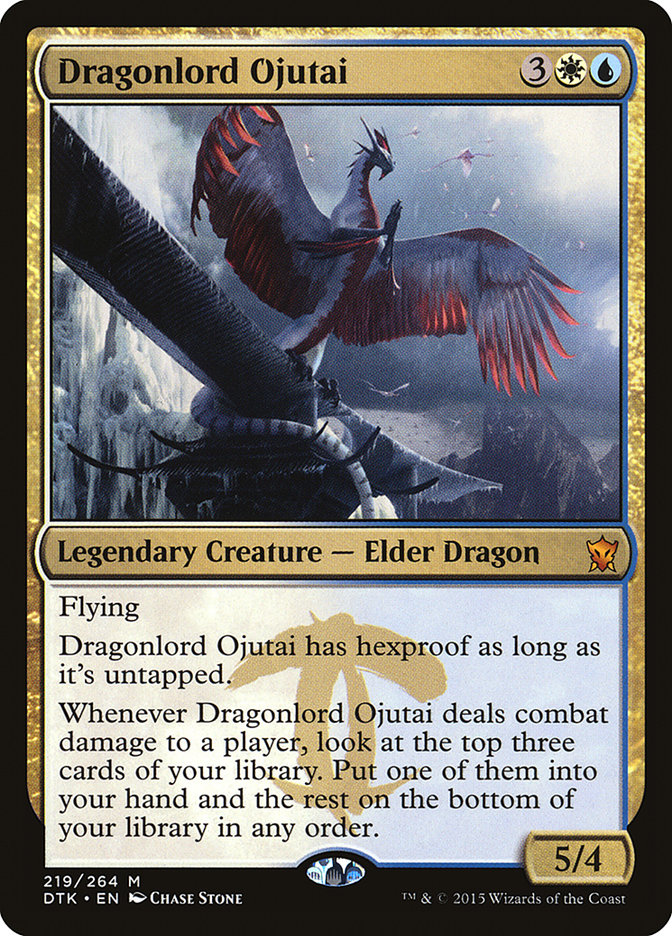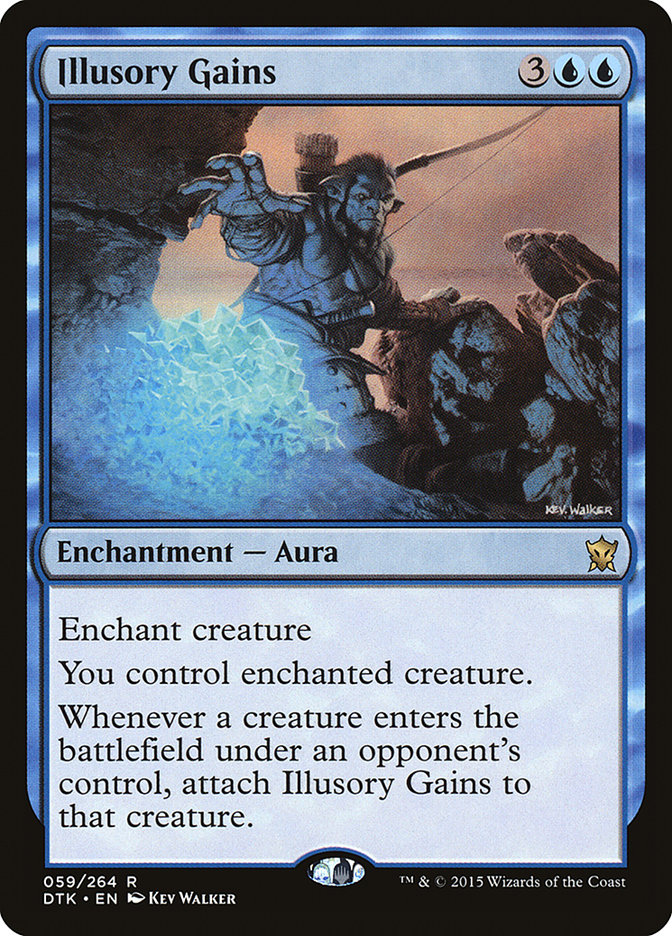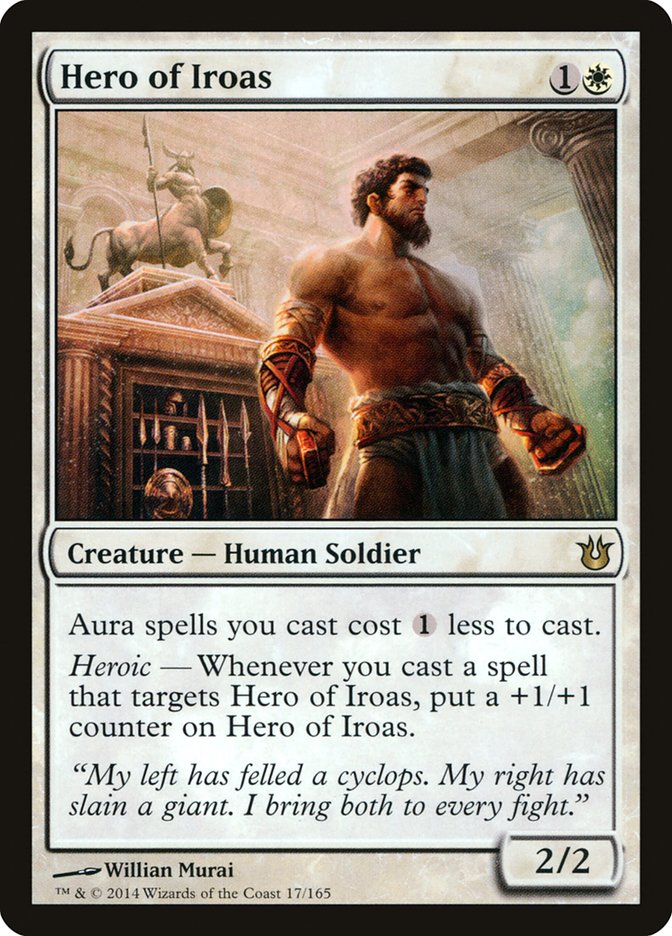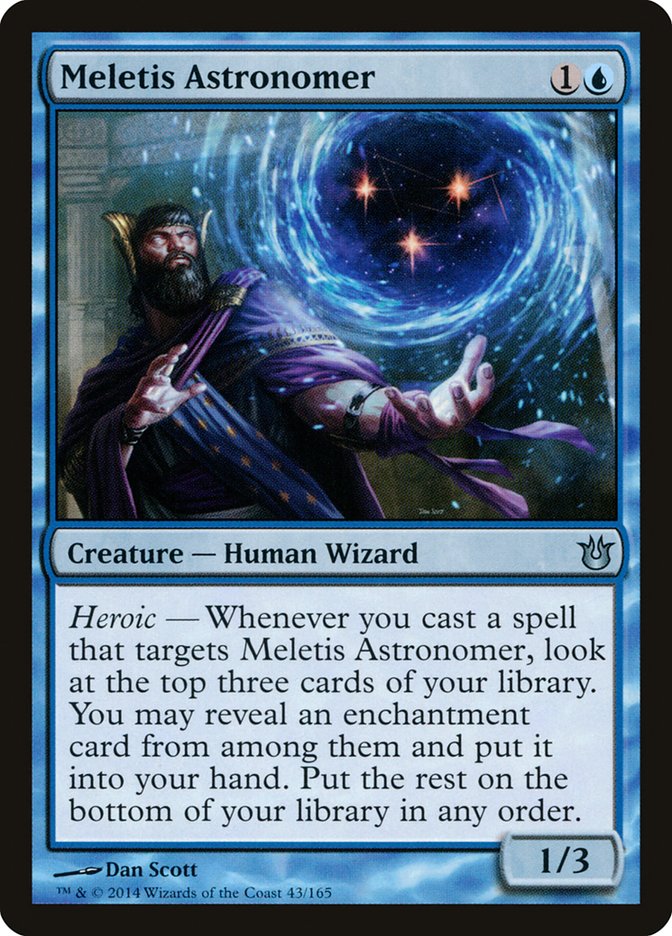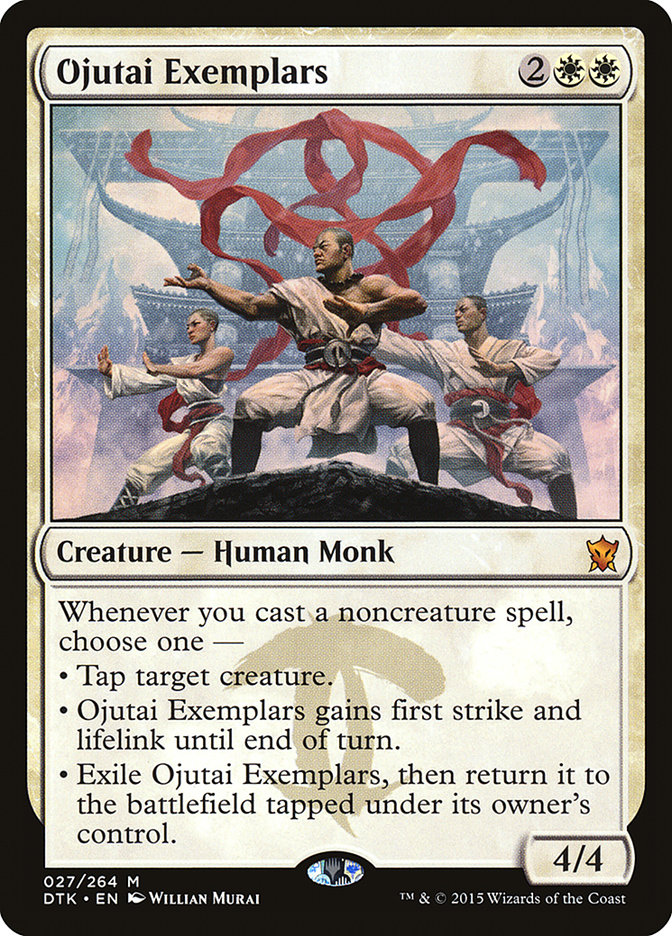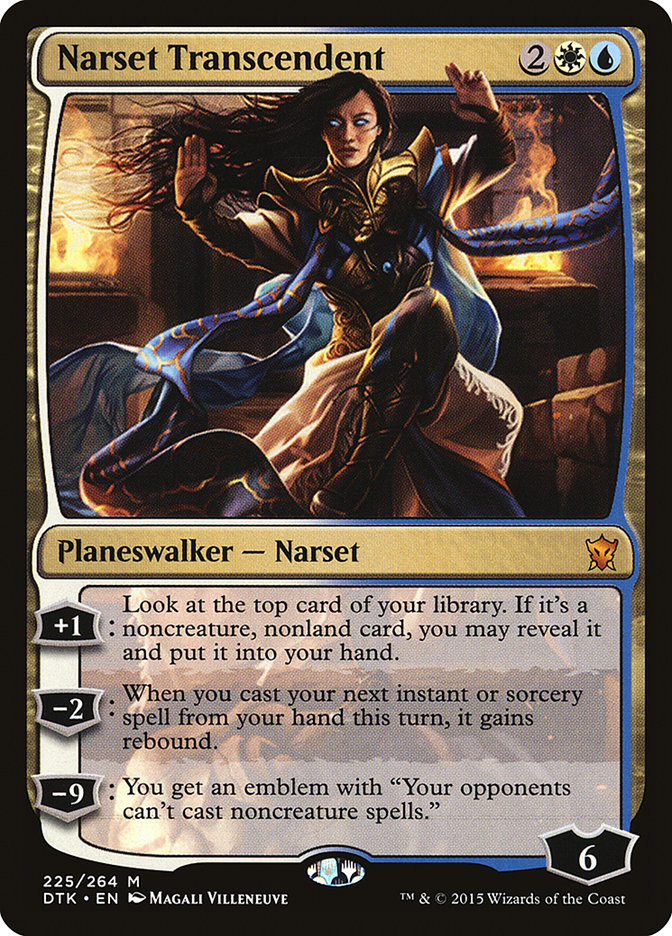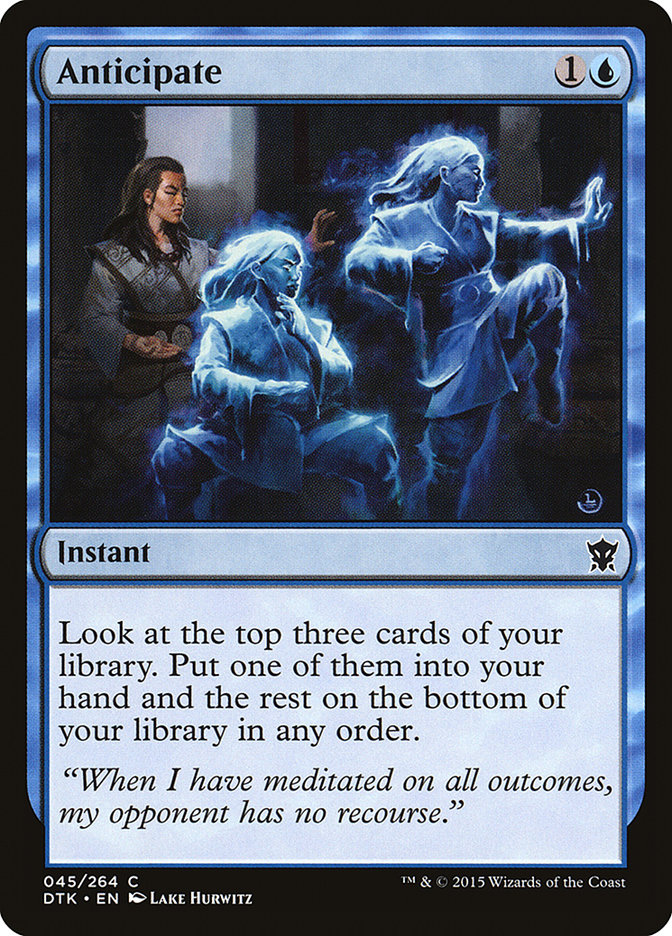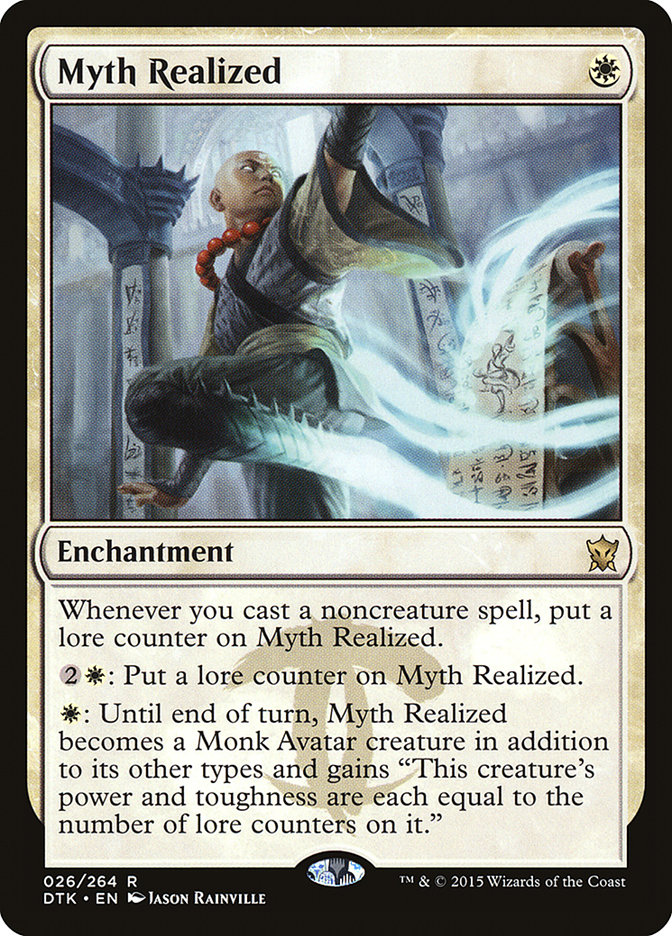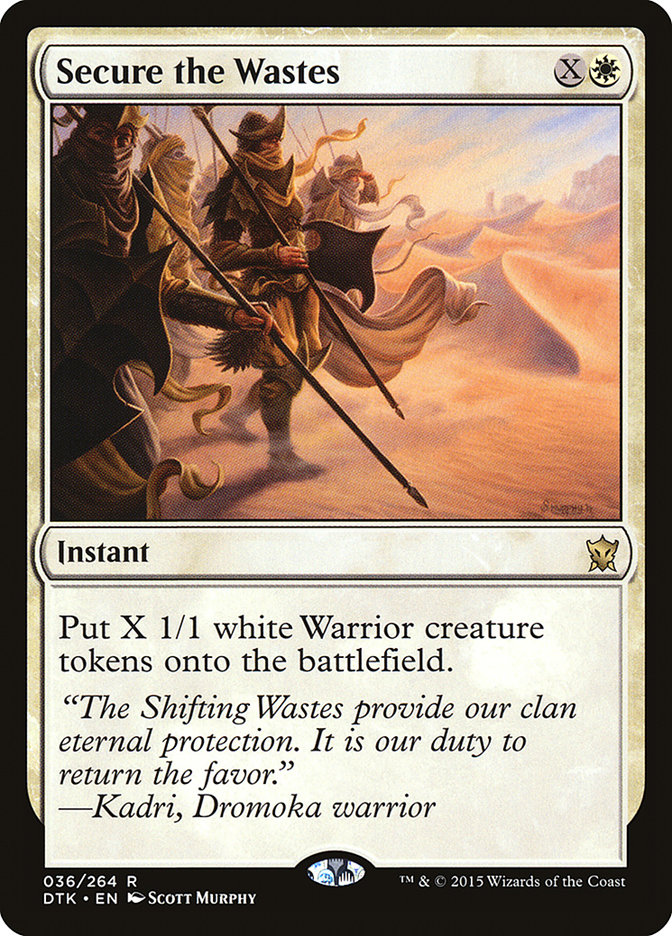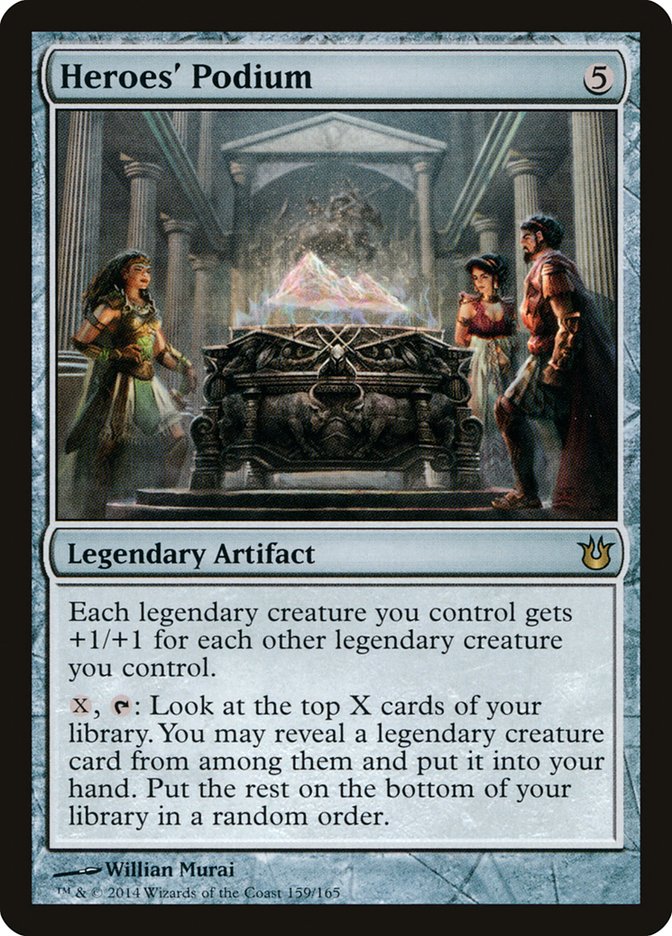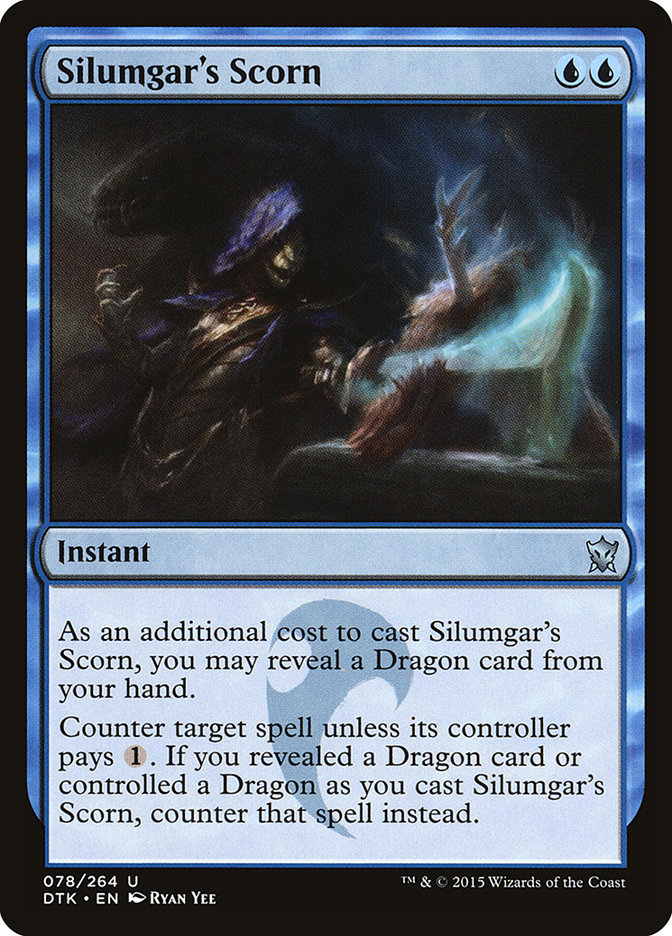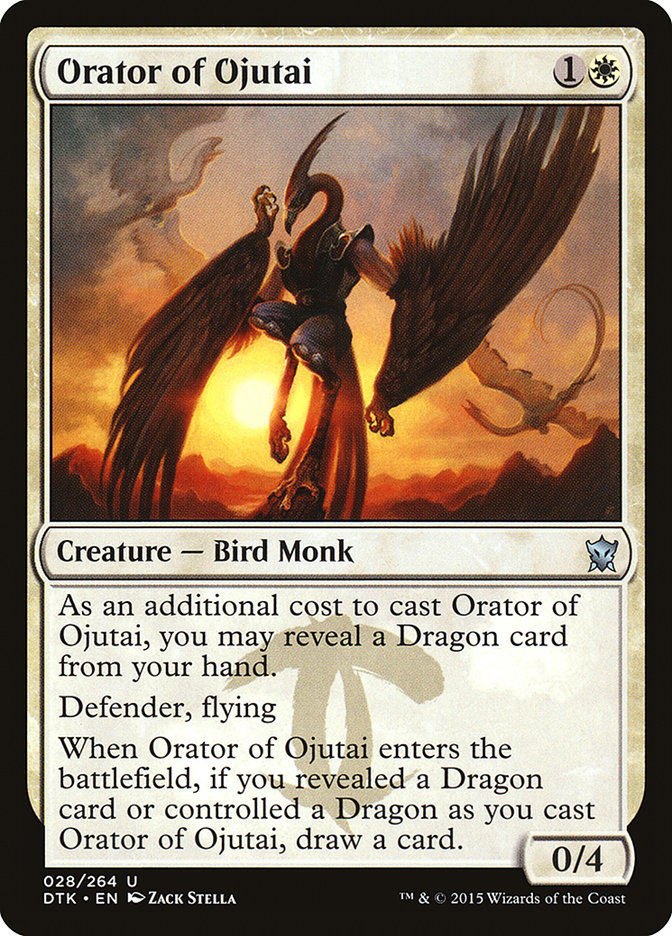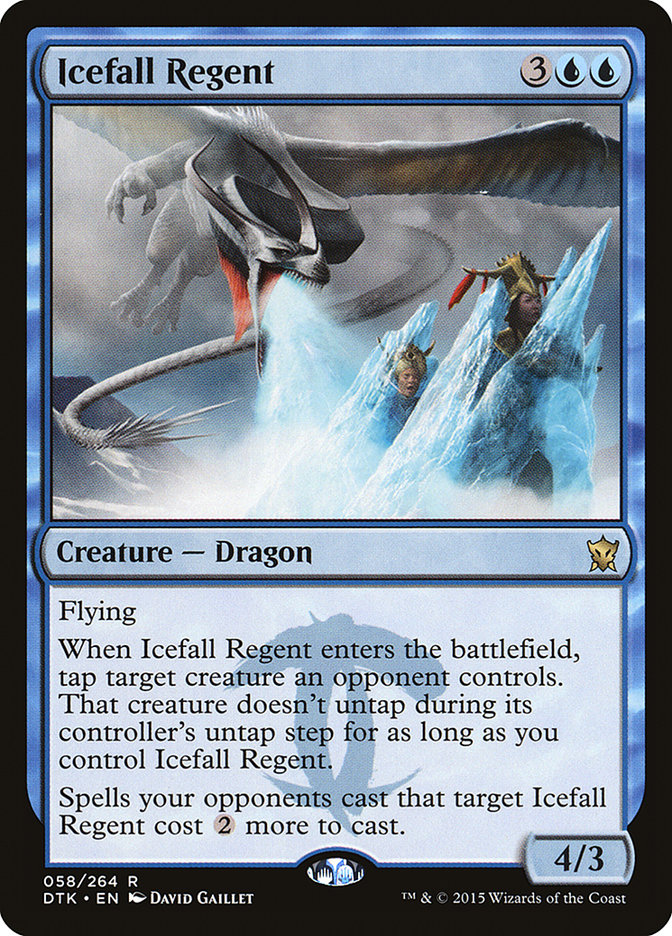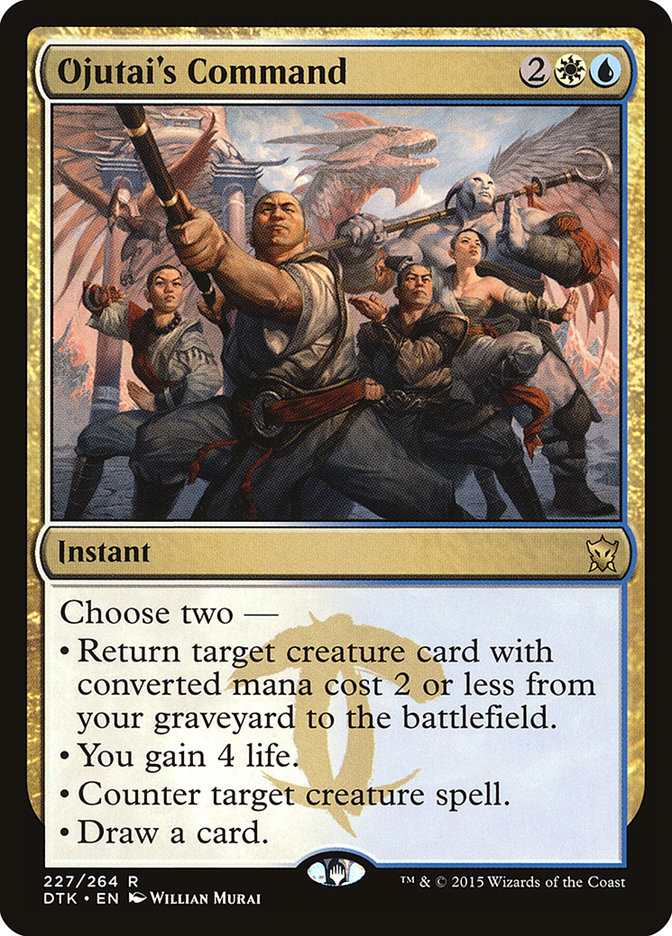I like to build decks.
Dragons of Tarkir delivers in the deckbuilding department, and this week I am taking a look at the cards it brings to Standard both in terms of updating
existing strategies, and making new strategies possible. Monday focused on black decks, including tons of non-black
cards that go into various black decks. Today’s focus is on white decks, so let’s dive in!
Alternate timeline Anafenza has captured the hearts and minds of many, getting enough hype to actually cross over into backlash space where people that
know enough to be dangerous are dismissing her as overrated.
As is always the case with strong new cards that inspire new decks to be built instead of just slotting into existing decks, Anafenza is doomed to be
misunderstood at first. At first, people will just want to be her in White Weenie decks since WW! Clever, right?
Wait, you’re telling me Precinct Captain appeared in non-White Weenie decks? How is that possible? WW?
Whoa, whoa, whoa, whoa. Whether we wish to White Weenie, where we welcome whatever Wizened Cenn we can, or wonder what wacky ways will work well with a way
wilder white Whirling Dervish, we will win. We’re waging a World War with the wily
water wizards, and with the wicked ones, the wild woodland summoners, and the wielders of the wildfire. When we are wise and weigh what we’ve got with the
whole wide world, wondering if we might be wrong, we’re wise and will weather the weather.
While we’re not working with a Warrior, we won’t worry. When we want a world-class weapon warmer than wasabi, we’ve got a worthy winner well worth the
wait. Watch who’s walking out of the woods and wailing on wannabes like Warwick (a werewolf who wrecks wounded weaklings without warning).
Let’s look at some lists!
Without wasting words writing weirdly?
Creatures (29)
- 4 Fleecemane Lion
- 4 Boon Satyr
- 4 Brimaz, King of Oreskos
- 3 Sunblade Elf
- 4 Warden of the First Tree
- 4 Mardu Woe-Reaper
- 1 Hidden Dragonslayer
- 3 Anafenza, Kin-Tree Spirit
- 2 Surrak, the Hunt Caller
Lands (23)
Spells (8)

This list is all about a good curve, some nice tempo tricks, and overwhelming opponents with powerful proactive plays.
Anafenza is not being used for some combo or anything. It’s just that if she puts a single counter on anything, you’ve already gotten your money’s worth,
and most of the time she dies, she would have died anyway. Yes, she is vulnerable to Wild Slash and Drown in Sorrow, but that is part of the price you pay
for the upside of potentially dominating the board with larger threats. Seeker of the Way, Soulfire Grand Master, and Goblin Rabblemaster are also 2/2s
that just die sometimes. That’s how it goes. That doesn’t mean they aren’t awesome.
Two important points to remember with Anafenza:
1. She doesn’t give counters to your tokens.
2. She does give counters to your manifest creatures.
I like the Dragonslayer better in midrange decks, but it’s fine for aggressive decks that just want to fill out their curve. If you have no other
two-drops, you should generally play it on turn 2 rather than wait to megamorph it. Eight two-drops isn’t a ton, but we’re going to activate Warden of the
First Tree on turn 2 a fair bit.
Surrak, the Hunt Caller is a quality four-drop in decks that realistically expect to have three power in play when you play him so that he is a 5/4 haste
with upside. Fleecemane Lion, Brimaz, and Boon Satyr all trigger Surrak on their own, but so does Anafenza since you get to bolster when Surrak enters the
battlefield.
Awesome. One of the best rewards for playing an aggressive green and white creature deck. Abzan Advantage was already playable, and this card is better in
half a dozen meaningful ways.
I’m not sure if I’m in love with this card, but it is cute that it works against opponents that try to block with Tasigur, Sidisi, Undead Vizier, or
Dragonlord Silumgar.
I am not super keen on Dragon Hunter. If you’re in the market for Warriors, okay, it’s fine, but in general, the ability is worth little and there are
plenty of two-power one-drops. I think we’ve got enough Plains to support Sunblade Elf, which actually adds a dimension to our gameplan.
It is interesting that Sunblade Elf is a Warrior. I wonder what a green Warrior deck would look like?
Creatures (27)
- 4 Sunblade Elf
- 2 Heir of the Wilds
- 4 Warden of the First Tree
- 4 Mardu Woe-Reaper
- 4 Hidden Dragonslayer
- 3 Arashin Foremost
- 2 Surrak, the Hunt Caller
- 4 Dragon Hunter
Lands (24)
Spells (8)

Heir of the Wilds looks awful here. We’d probably be better off with Dromoka Warrior. Yes, we’re all Warriors and Obelisk of Urd, so that can win games,
but why these 27 Warriors? It’s not like 27 is a lot. In fact, I’d prefer an Obelisk deck have more, and this list doesn’t even have token making, which is
where Obelisk really shines.
Surrak is pretty awkward here too. There are going to be so many times where you play him and have exactly seven power. This list is a good reminder of the
importance of synergy in deck design. It’d be one thing if this was just a laundry list of the best cards in the format, but it’s actually mostly solid
cards and roleplayers.
Okay, this card is awesome. In the right deck, it is competitive with and sometimes better than Silverblade Paladin. It’s poorly used here, as we’re rarely
giving double strike to anything with more than two power, and my goodness is it awkward when you cast Surrak, the Hunt Caller and this is your only other
creature. Let’s find a different deck for the Foremost.
Okay, what if we cut green?
Creatures (29)
- 4 Soldier of the Pantheon
- 4 Brimaz, King of Oreskos
- 2 Seeker of the Way
- 4 Mardu Woe-Reaper
- 4 Hidden Dragonslayer
- 4 Arashin Foremost
- 3 Anafenza, Kin-Tree Spirit
- 4 Dragon Hunter
Lands (22)
- 22 Plains
Spells (9)

Look at you! Finally resisted the urge to fill a deck with Obelisks and the first 30 Warriors you can find!
Arashin Foremost is a different sort of tribal reward than cards like Obelisk that heavily push you towards being all-in. Arashin Foremost only affects one
creature at a time, so if you have a Warrior and a non-Warrior, you aren’t necessarily any worse off. This means even though we have incentive to lean
towards Warriors, we can play cards like Anafenza, Kin-Tree Spirit and Brimaz, King of Oreskos because of their raw power level.
My biggest concern with a deck like this is that green decks will often go over the top of us (whether devotion or graveyard), while control decks won’t
have a ton of problem one-for-one trading with us, then beating us with Dig Through Time. Even Abzan decks can just go over the top of us with
planeswalkers or Sidisi since they won’t have much trouble keeping up with one-for-one removal. We need to do something, whether it’s to get faster, or
more powerful. We either need more raw power or more synergy.
Creatures (22)
- 2 Phalanx Leader
- 4 Favored Hoplite
- 4 Soldier of the Pantheon
- 4 Brimaz, King of Oreskos
- 4 Herald of Anafenza
- 4 Anafenza, Kin-Tree Spirit
Lands (22)
- 22 Plains
Spells (16)
Sideboard

Ahh, I see. That didn’t take long.
Look, I know there are a lot of possible Obelisk decks, but there is profit in keeping an eye on each possibility for the savvy deckbuilder. The fact that
so many creatures have two relevant types makes for a lot of interesting combinations. For instance, we could build a W/B Humans list and still take
advantage of Warrior synergies like Arashin Foremost.
What other synergies are there besides Obelisk?
Creatures (30)
- 4 Ajani's Pridemate
- 4 Soldier of the Pantheon
- 4 Brimaz, King of Oreskos
- 3 Wingmate Roc
- 4 Mardu Woe-Reaper
- 4 Hidden Dragonslayer
- 3 Anafenza, Kin-Tree Spirit
- 4 Dragon Hunter
Lands (24)
Spells (6)

This is a better attempt and actually has a few things going for it; however, at the end of the day, this deck isn’t hitting from enough angles. We’re
still just going to lose to removal + card draw/planeswalkers, and we’re still too slow and too poorly set up to interact with green decks that go over the
top of us.
Yes, it’s cute that we’ve got tons of lifegain triggers to make Ajani’s Pridemate a good card in our deck, but it’s not like that’s even some big thing.
The only people without Ultimate Price or Valorous Stance play cards like Deathmist Raptor, Whisperwood Elemental, or Hornet Queen, all of which do much
bigger things than the Pridemate dares dream.
What about white devotion? Anafenza is a great source of white mana symbols, and Nykthos is a great way to power Mastery of the Unseen!
Creatures (24)
- 4 Soldier of the Pantheon
- 4 Brimaz, King of Oreskos
- 2 Soul of Theros
- 2 Wingmate Roc
- 4 Mardu Woe-Reaper
- 4 Anafenza, Kin-Tree Spirit
- 4 Dragon Hunter
Planeswalkers (2)
Lands (25)
Spells (9)

Look, I like where your heart’s at, but why is this better than G/W Devotion?
Good point. It surely isn’t. The card quality isn’t as high, and the early plays are quickly outclassed in white aggro decks, while green’s have utility
later as mana sources to fuel Genesis Hydra, Polukranos, and Mastery of the Unseen. It is interesting, however, that white devotion is the one color that
has never really had its day in the sun. Maybe it never will, but I could imagine R&D members planting something somewhere to possibly breathe life
into the archetype, to mix it up on people.
G/W Devotion is one of the decks to beat, so let’s take a look at it to get an idea of the bar for our decks and to consider if we should just be tuning
it.
Creatures (32)
- 4 Elvish Mystic
- 3 Polukranos, World Eater
- 2 Sylvan Caryatid
- 2 Voyaging Satyr
- 4 Courser of Kruphix
- 4 Genesis Hydra
- 4 Rattleclaw Mystic
- 4 Whisperwood Elemental
- 4 Deathmist Raptor
- 1 Ainok Survivalist
Lands (24)
Spells (4)

Deathmist Raptor is crazy good. A 3/3 deathtouch for three is not that far off, and if we’re ever able to bring it back, we are way ahead. Mastery of the
Unseen and Whisperwood Elemental are very good at ensuring the Raptor never stays dead. We can also replace either Voyaging
Satyr or Sylvan Caryatid with Rattleclaw Mystic for extra flips.
This is far from the only deck that can use Deathmist Raptor, but it is an easy place to start. A couple of notes about Deathmist Raptor:
● If you are confident your opponent has Abzan Charm, you can play the Raptor face down and bring it back face down every time.
● If you are confident your opponent has Magma Spray, you can play the Raptor face up and bring it back face up every time.
● Deathmist Raptor probably means an increase in Anger of the Gods, which is interesting to consider for deckbuilding.
Ainok Survivalist is another way to get back Deathmist Raptor, of course, but I could imagine us wanting to replace Reclamation Sage with it anyway. When
you are using Mastery of the Unseen in the mid or lategame, it’s nice to be able to find your solution to cards like Whip of Erebos or your opponent’s
Mastery of the Unseen. If you manifest a Reclamation Sage, you can’t get the trigger without also finding a Temur Sabertooth. However, Ainok Survivalist
works great with Manifest, even coming out of it with a +1/+1 counter.
Den Protector is a tricky one. It is another flip for our Raptor, which is a thing. The ability to buy an overcosted Eternal Witness is also something,
albeit a bit wasted here. It’s also got a minor evasion ability that we don’t fully appreciate. As a package deal, I want to pass, but I could imagine
plenty of better homes for it, like maybe some kind of Abzan Raptor deck with Satyr Wayfinders. Satyr Wayfinder flipping Deathmist Raptor is filthy, and
the more you mill, the more options you’ll have for your Den Protector to get back. Abzan Charm, Hero’s Downfall, and Siege Rhino are pretty attractive
Regrowth targets. The Siege Rhinos and maybe other aggressive creatures (like Fleecemane Lion) even make the evasion more meaningful.
Another possible synergistic path to explore is the +1/+1 counter theme that has been growing over the past year. The printing of Avatar of the Resolute,
Gleam of Authority, and Inspiring Call give us a lot of real payoffs for embracing the linear strategy in this direction. Anafenza, Kin-Tree Spirit,
Servant of the Scale, and Dromoka’s Command give us a bunch of new “enablers” to help fuel our strategy.
Creatures (21)
- 4 Phalanx Leader
- 4 Favored Hoplite
- 1 High Sentinels of Arashin
- 2 Abzan Falconer
- 2 Anafenza, Kin-Tree Spirit
- 4 Avatar of the Resolute
- 4 Servant of the Scale
Lands (22)
Spells (17)

Avatar of the Resolute is a boss! Cast it without getting a single pump and you are still getting a 3/2 trampler with reach for two. That’s really not bad
once you’ve already paid the cost on your manabase. The trample is particularly great with all of the ways we have to pump our creatures, and the reach
gives us ways to interact with Mantis Rider, Stormbreath Dragon, and even Silumgar, the Drifting Death!
Where Avatar of the Resolute gets exciting is how effectively it scales without costing any more mana. If you get any counters at all, you are
ahead, and it’s not going to be uncommon to get several, which also has the added benefit of greatly increasing the power of any creature wielding Gleam of
Authority.
This one might be a sleeper hit. It’s a weird card that isn’t like previous good cards, so it’s hard to evaluate, and most are writing it off. The thing
is, it’s generally going to be at least +2/+2 with the implied threat of an extra +2/+2 a turn, and it won’t be rare to get +6/+6 or more. Remember, it
counts the total number of counters on your other creatures, not the number of creatures with counters, so the number can get real big real fast. It
doesn’t count the counters on the creature wielding it, however, so you really want two creatures in play at a time.
On top of huge stats, Gleam of Authority gives vigilance, which isn’t a big deal, but creatures like Avatar of the Resolute make great use of the ability.
Turn 1: Hardened Scales
Turn 2: Servant of the Scale
Turn 3: Avatar of the Resolute as a 6/5.
Turn 4: Gleam of Authority, making the Avatar an 8/7 that can become a 10/9 in combat by using its tap ability while also making the Servant of the Scale
into a 4/4.
Trample is obviously awesome on giant creatures, but vigilance with reach means opponents are going to have a real hard time racing you at all. Even less
nutty draws without Hardened Scales play right into the Avatar + Gleam gameplan. Even without Scales, it takes just two +1/+1 counters on your other
creatures make the Avatar into an 8/7 after you Gleam it and use the ability. Of course, you might want to spread your investment around a bit.
Turn 1: Favored Hoplite
Turn 2: Anafenza, Kin-Tree Spirit
Turn 3: Abzan Falconer, bolster Anafenza
Turn 4: Gleam of Authority on the Favored Hoplite, attack, and use the ability to pump the Abzan Falconer before blocks. Now you’re attacking for ten in
the air.
Gleam of Authority’s ability to grow your team is going to surprise people with how quickly it takes over a game. Yes, it folds to removal, but you’re
gaining a +1/+1 counter a turn in the meantime, effectively +2/+2 as long as the creature lives.
Want to have a good time? Cast Gleam of Authority on a Phalanx Leader…
Servant of the Scale is a nice role-player for all-in +1/+1 counter decks. We need another one-drop anyway, and even without combos the Servant is pretty
respectable. It gives you 1/1 worth of stats now and 1/1 later, and stuff you have to wait on is often worth half of something you get now; however, the
Servant gets double value out of cards that grant counters. It makes a great card to invest your pump spells into since even if your opponent kills it, you
still get the value.
Hardened Scales is particularly sweet with Servant of the Scale, as you might guess from the name. The Servant comes down as a 2/2, then gives something
+3/+3 when it dies, and that’s assuming you never pumped the Servant with anything.
This is the exact type of card that some players get super excited about because of the massive potential upside when things are going well. It’s fun to
imagine the possibilities.
It’s also the exact type of card that some other players love to make fun of. After all, things aren’t always going to be going well, and the floor on this
one is stone zero. There are going to be times you try to just cycle this for three mana and get nothing at all because of a timely removal spell.
So, who’s right? Well, as you might imagine, this type of thing can go either way. The spikey perspective that writes it off is going to be right more
often than not; however, the creative deckbuilder is going to find those exceptions more often.
The odds are against it, but I know I’m going to keep looking for a sick Inspiring Call deck. It’s the type of thing that could go from fringe to amazing
very quickly, like Elf Combo after the printing of Elvish Visionary right after Nettle Sentinel and Regal Force.
While most of the Inspiring Call fantasies involve drawing tons of cards, the part of the card that’s really interesting to me is the ability to make our
team indestructible. Just countering a Hero’s Downfall (and drawing at least one card) is a big game, and responding to an End Hostilities or Crux of Fate
is a very big game.
While the above list is speculative, Gleam of Authority is also an interesting addition to W/U Heroic.
Creatures (19)
- 4 Battlewise Hoplite
- 4 Favored Hoplite
- 4 Hero of Iroas
- 4 Heliod's Pilgrim
- 1 Seeker of the Way
- 2 Monastery Mentor
Lands (22)
Spells (19)

Gleam of Authority is a fine Heliod’s Pilgrim tutor target in a more traditional Heroic deck, but what I’m really interested in is a new Heroic deck with
Phalanx Leader, and maybe more Monastery Mentor action or Brimaz.
Heliod’s Pilgrim being able to fetch removal is an exciting new dimension that costs very little space in our list. Illusionary Gains is not the worst
either, but it’s too expensive for a 22-land deck.
Heliod’s Pilgrim’s ability to find Chained to the Rocks has spawned multiple new archetypes, and the plethora of good targets to find in Dragons of Tarkir
might spawn more. For instance, what about something like:
Creatures (18)
Lands (25)
Spells (17)
- 4 Pacifism
- 1 Ordeal of Heliod
- 2 Ordeal of Thassa
- 1 Hubris
- 1 Mortal Obstinacy
- 1 Spectra Ward
- 2 Valorous Stance
- 2 Sage's Reverie
- 1 Mirror Mockery
- 1 Gleam of Authority
- 1 Illusory Gains
Sideboard

Okay, this one is pretty out there, but there some cool things going on here.
Sage’s Reverie draws a card on its own, but it also draws you a card for every Pacifism, as well as all of the specialty auras.
Mirror Mockery can be used as a Pacifism of sorts since it makes opponents really not want to attack with creatures like Siege Rhino, but you can also put
it on your Heliod’s Pilgrim to build a makeshift engine of sorts. If you use the copy to go get Sage’s Reverie, it’s not hard to draw enough cards so that
if your opponent draws removal for the Pilgrim, you are still way ahead.
Gleam of Authority grants vigilance, making Dragonlord Ojutai hexproof all the time while also drawing you cards, dealing damage, and blocking.
Yeah, I’d prefer Mind Control, but it’s not legal. The ability to tutor up a Control Magic effect might just be a big enough game to be worth the
unreliability of Illusory Gains. Opponents casting Raise the Alarm is annoying though. Maybe too annoying.
The Hero is excellent here, being not only a great target for our positive auras but a potent mana accelerator, often saving us multiple mana per turn.
I didn’t use the Astronomer, but I’m not convinced it’s out of the question once we’re playing this many auras.
There are so many possible new W/U decks because of Dragons of Tarkir. Monastery Mentor was already good, and I think its stock is rising.
Creatures (10)
Planeswalkers (4)
Lands (25)
Spells (21)

This list seeks to exploit a plethora of prowess and prowess-like abilities with lots of cheap, quality instants. It plays much more of a midrange game
than a traditional control deck would, dominating the board with cards like Monastery Mentor and Ojutai Exemplars rather than removing every opposing
threat.
Ojutai Exemplars is not trivial to operate, and it will die a lot more than Aetherling, lifelink less than Baneslayer, and tap down opposing creatures less
than Blinding Angel, but it does all of these things some of the time while also being a 4/4 for four. I’m a fan.
A fine card, but the $50 tag suggests to me that she is overrated. This is a powerful set with a ton of great cards. I think she’s better than Kiora, but
that’s not the highest bar in the world. I’d way rather have a Jace, Architect of Thought. That said, I’m still using her in spots where appropriate. She
has tons of loyalty, draws a card every other turn, and is a mondo-combo with Dig Through Time.
I’m a big fan of this card. It’s the best cheap library manipulation spell since the Ponder/Preordain era. An in-depth explanation of why can be found here.
Anticipate goes a long way towards smoothing out our draws while also fueling Dig Through Time, but it also has some mondo combos. If you Narset and see a
land on top you don’t want, cast Anticipate and you can effectively scry it to the bottom.
It also gives a cheap instant we can use to trigger our Seeker of the Way, Monastery Mentor, and Ojutai Exemplars while also finding another spell for a
double activation.
This one is a tough one to evaluate without some games. In your opening hand, it can be totally filthy, quickly growing to an unstoppable size with very
little mana investment. Later in the game, it doesn’t grow as fast naturally, but you can sink extra mana into it. As a bonus, Myth Realized is a
non-creature spell, triggering all of your other prowess paraphernalia.
The problem? Not everyone is just going to sit around and let you do whatever you want. Myth Realized has no impact on the board until you pay the mana
activation. This means you might sit around getting nothing out of it for four turns, then when you go to use it, it gets Hero’s Downfalled. While it hides
from some spot removal until you use it, it’s even weaker against Dromoka’s Command, which can hit it at any point. I am not optimistic about this one, but
I want to try it.
Now, Secure the Wastes is a card I am optimistic about. It’s just one mana more than Raise the Alarm for the possibilities of getting a massive payoff in
the middle or lategame. It’s not like spending three mana to get two 1/1s is the end of the world, and you can even make zero tokens in a pinch to save
your Ojutai Exemplars from a removal spell if you are short on mana.
Another place I want to try Secure the Wastes is in Jeskai Tokens. It seems like a perfect fit.
Creatures (3)
Lands (25)
Spells (32)

Dragon Fodder on top of Raise the Alarm, Secure the Wastes on top of Hordeling Outburst, we now have access to a crazy amount of token-making. We just need
to make sure we don’t lose to Virulent Plague!
Hold on there, playa! That deck looks suspiciously close to actually good. Can we get some longshot crazy brews up in this place?
Heroes’ Podium has gained a ton of new options over the past two sets.
Creatures (21)
- 3 Polukranos, World Eater
- 4 Brimaz, King of Oreskos
- 4 Anafenza, the Foremost
- 2 Tasigur, the Golden Fang
- 1 Sidisi, Undead Vizier
- 1 Dragonlord Dromoka
- 3 Anafenza, Kin-Tree Spirit
- 3 Surrak, the Hunt Caller
Lands (25)
Spells (14)

How many legends are we really going to have in play at the same time? If the answer is usually three or more, Heroes’ Podium has a reasonable impact on
the board the turn you play it. If the answer is less, we might need to get more interactive and slow down a bit and rely on the Podium as a card drawer.
The Coat of Arms ability of Heroes’ Podium is very challenging to make work given just how many different legends you need to play. However, you are
getting it on top of a card draw engine that is harder to remove than planeswalkers like Narset or enchantments like Outpost Siege.
Hero’s Blade is less ambitious but is a pretty good deal once your deck is full of legends. Is this enough of a payoff to go to the trouble? I am
skeptical, but it’s fun seeing if there might be a way to make it happen.
Surrak, the Hunt Caller is a real good target for Hero’s Blade!
There aren’t really all that many black cards in that list. If we try red instead, we can bring the curve down a bit.
Creatures (23)
- 1 Elvish Mystic
- 3 Polukranos, World Eater
- 1 Sylvan Caryatid
- 3 Brimaz, King of Oreskos
- 2 Yisan, the Wanderer Bard
- 2 Yasova Dragonclaw
- 1 Dromoka, the Eternal
- 2 Alesha, Who Smiles at Death
- 2 Zurgo Bellstriker
- 1 Dragonlord Dromoka
- 3 Anafenza, Kin-Tree Spirit
- 2 Surrak, the Hunt Caller
Lands (25)
Spells (12)
Sideboard

Man, these lists look dubious, but they look so fun. I would love to find a playable list that uses ten different legends! Juggling all of the different
abilities seems like such a good time.
What if we bring the curve down even more? If we cut the Polukranos and Surrak types for Zurgo Bellstriker and Tymaret, the Murder King, we can actually
get down to a pretty realistic aggro curve.
Creatures (22)
- 1 Anax and Cymede
- 3 Tymaret, the Murder King
- 4 Brimaz, King of Oreskos
- 1 Zurgo Helmsmasher
- 1 Kolaghan, the Storm's Fury
- 1 Tasigur, the Golden Fang
- 3 Alesha, Who Smiles at Death
- 3 Zurgo Bellstriker
- 1 Dragonlord Kolaghan
- 4 Anafenza, Kin-Tree Spirit
Lands (25)
Spells (14)
Sideboard

It’d probably be better to just play another Alesha, Who Smiles at Death instead of Anax and Cymede since we can’t really use their ability; however, there
might be some value to be able to have both in play at the same time.
Kurkesh, Onnake Ancient is an amusing option, even copying your Heroes’ Podium activations, but its body is too bad, and the ability is only useful when
things are going well.
What about full-on crazy mode? I’m guessing three colors is more likely to work, but four (or more colors) isn’t necessarily out of the question.
Creatures (24)
- 2 Polukranos, World Eater
- 2 Tymaret, the Murder King
- 2 Brimaz, King of Oreskos
- 2 Yisan, the Wanderer Bard
- 2 Anafenza, the Foremost
- 1 Kolaghan, the Storm's Fury
- 2 Yasova Dragonclaw
- 1 Tasigur, the Golden Fang
- 2 Alesha, Who Smiles at Death
- 2 Zurgo Bellstriker
- 1 Dragonlord Kolaghan
- 3 Anafenza, Kin-Tree Spirit
- 2 Surrak, the Hunt Caller
Lands (25)
Spells (12)
Sideboard

It sucks to play so many tapped lands, and we probably need more removal, but it is interesting to see just how many playable legends there are. We haven’t
even touched on Sidisi, Brood Tyrant, Dragonlord Silumgar, and so on.
My guess is that Heroes’ Podium doesn’t pan out, but if it does, I wouldn’t be surprised if the right approach is to be less all in. You could just play a
normal deck that happens to have 2-4 copies of five, maybe six different legends, and then only one or two Heroes’ Podiums, using it as a lategame plan to
take over the game.
I could also imagine people playing Hero’s Blade in non-Podium decks. For instance:
Creatures (22)
- 1 Polukranos, World Eater
- 4 Fleecemane Lion
- 4 Brimaz, King of Oreskos
- 3 Anafenza, the Foremost
- 4 Siege Rhino
- 1 Surrak Dragonclaw
- 2 Tasigur, the Golden Fang
- 3 Anafenza, Kin-Tree Spirit
Lands (25)
Spells (13)

Even this list might be too legend-oriented. Hero’s Blade can still work on non-legends, so it’s possible we just have enough legends to make the Blade a
good deal on mana enough of the time.
We’ve talked about a lot of linears encouraged by Dragons of Tarkir today, including Warriors, Flip-Triggers, Devotion, +1/+1 Counters, and Legends. What
about actual Dragons?
Creatures (13)
- 2 Silumgar, the Drifting Death
- 2 Dragonlord Silumgar
- 2 Dragonlord Ojutai
- 3 Icefall Regent
- 4 Orator of Ojutai
Lands (26)
Spells (21)

This list has a lot of similarities to U/W Control, but it plays a tap-out game involving lots of Dragons. This is partially just because there are so many
good Dragons and partially to get to play with Counterspell and a better Wall of Omens:
With nine Dragons, we’re going to have one on my turn 2 over 75% of the time. Even if we don’t yet, Silumgar’s Scorn as a Force Spike can do a lot, and
Orator of Ojutai can still come down as a blocker if needed.
In addition to these two big payoffs, we can use the Dragon-lands to keep the Dragons coming in the lategame. They also let us splash the two awesome
Silumgar dragons easily.
Like Frost Titan, I kind of imagine Icefall Regent is going to be underrated at first. I don’t think it’s insane or anything, but it’s not bad, as far as
Dungeon Geists go. The fact that it gives you access to Silumgar’s Scorn is a pretty big game. It even powers up Dragonlord’s Prerogative if we want an
advantage against other blue decks.
However, if we’re considering such a new style of control deck, it’d be good to have an idea of what the baseline is. What does control look like without
Dragons? After all, it’s not like Dragons of Tarkir is shy on cards for other U/W decks…
Planeswalkers (6)
Lands (26)
Spells (28)

Narset and Anticipate are no surprise, but there are some ripples caused by their printing. For instance, Nullify gets better when we have Anticipate to
take advantage of the turns where we hold mana up but don’t use it. We also don’t need as much card draw now that we have Anticipate to smooth out our
draws, and Narset gives us more ways to build an advantage.
We also have less need to win with Pearl Lake Ancient than we used to. Elspeth is already a big game, and Narset can lock people out of being able to
Hero’s Downfall an Elspeth down the road. Plus, now we have Secure the Wastes, which does a mean Decree of Justice impression. It may not be an
uncounterable cantrip, but you do get two extra tokens!
Everyone is all about this card, but it seems only okay to me if you don’t have two-drops. It’s still a fine weapon against burn (cantrip gain four life), but the ideal home for it is a deck with cards like Seeker of the Way or Soulfire Grand Master, possibly even Jeskai
Sage or Ajani’s Pridemate. There are definitely plenty of metagames where we want multiples of these maindeck, but I doubt it will be the four-of copy
maindeck staple that some people seem to expect (again, unless we’re talking some new two-drop-based deck).
One last note on control decks: This format is shaping up to be another one where control decks want to have a diverse mixture of options in the sideboard
for adding proactive dimensions to their gameplan. Playing reactive cards is inherently weaker than proactive cards; however, not all cards have equal
power or synergy, plus we do get some advantages that can often overcome this, particularly if we correctly anticipate the field so that our reactive cards
line up well.
A lot of opponents are going to have dead cards game 1, which is a nice advantage, but it goes away after game 1. Of course, if we have a diverse mix of
proactive cards with very different vulnerabilities, we can get a lot of the value of proactive cards, while our opponents are often going to be struggling
to find the right answer.
Alright, I’m out for today, but I will return Friday to conclude my Dragons of Tarkir review. Major thanks to everyone providing suggestions and supplying
questions about the cards and decks discussed. I will make sure Friday, to cover every card, deck, topic, or question you guys have asked this week. So
keep them coming!
See you Friday!


